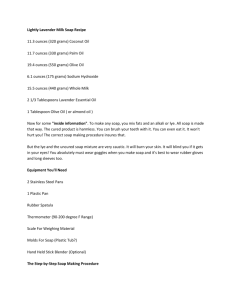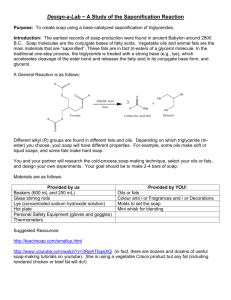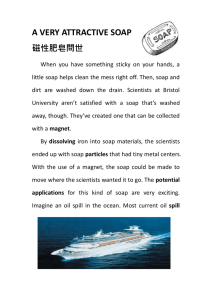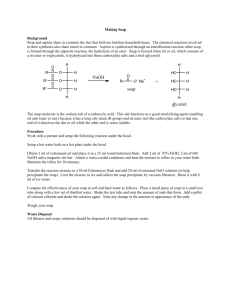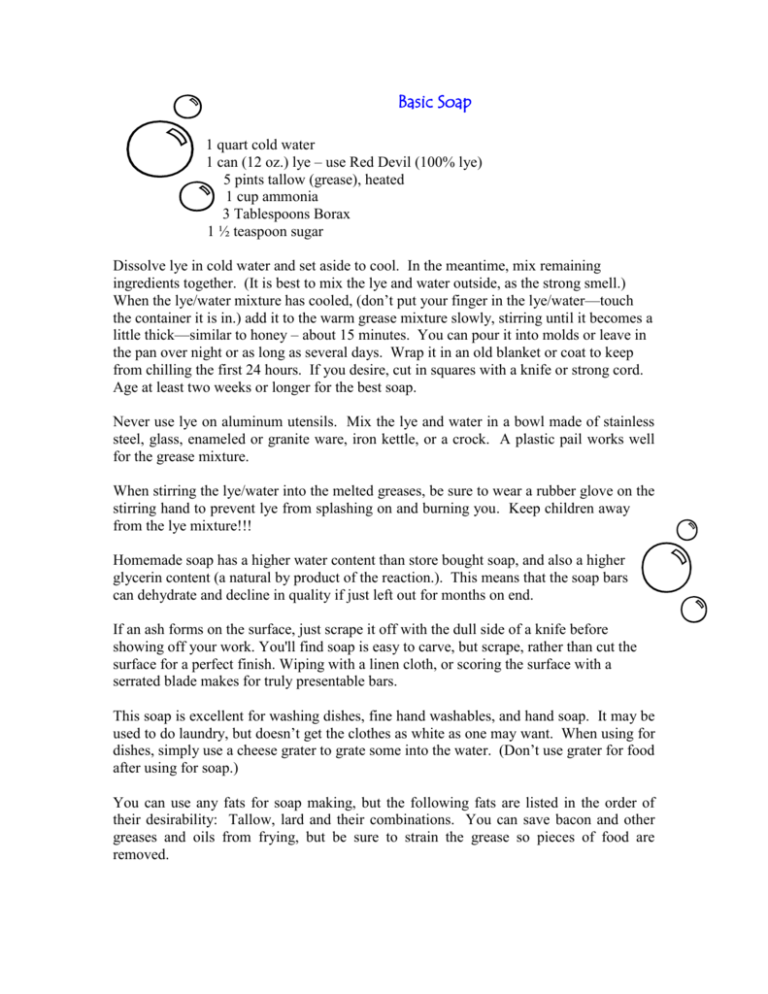
Basic Soap
1 quart cold water
1 can (12 oz.) lye – use Red Devil (100% lye)
5 pints tallow (grease), heated
1 cup ammonia
3 Tablespoons Borax
1 ½ teaspoon sugar
Dissolve lye in cold water and set aside to cool. In the meantime, mix remaining
ingredients together. (It is best to mix the lye and water outside, as the strong smell.)
When the lye/water mixture has cooled, (don’t put your finger in the lye/water—touch
the container it is in.) add it to the warm grease mixture slowly, stirring until it becomes a
little thick—similar to honey – about 15 minutes. You can pour it into molds or leave in
the pan over night or as long as several days. Wrap it in an old blanket or coat to keep
from chilling the first 24 hours. If you desire, cut in squares with a knife or strong cord.
Age at least two weeks or longer for the best soap.
Never use lye on aluminum utensils. Mix the lye and water in a bowl made of stainless
steel, glass, enameled or granite ware, iron kettle, or a crock. A plastic pail works well
for the grease mixture.
When stirring the lye/water into the melted greases, be sure to wear a rubber glove on the
stirring hand to prevent lye from splashing on and burning you. Keep children away
from the lye mixture!!!
Homemade soap has a higher water content than store bought soap, and also a higher
glycerin content (a natural by product of the reaction.). This means that the soap bars
can dehydrate and decline in quality if just left out for months on end.
If an ash forms on the surface, just scrape it off with the dull side of a knife before
showing off your work. You'll find soap is easy to carve, but scrape, rather than cut the
surface for a perfect finish. Wiping with a linen cloth, or scoring the surface with a
serrated blade makes for truly presentable bars.
This soap is excellent for washing dishes, fine hand washables, and hand soap. It may be
used to do laundry, but doesn’t get the clothes as white as one may want. When using for
dishes, simply use a cheese grater to grate some into the water. (Don’t use grater for food
after using for soap.)
You can use any fats for soap making, but the following fats are listed in the order of
their desirability: Tallow, lard and their combinations. You can save bacon and other
greases and oils from frying, but be sure to strain the grease so pieces of food are
removed.
The natural smell of the soap is good. If perfumed soap is desired, the following oils are
recommended (preferably the synthetic or imitation: Sassafras – 4 tsp.; lavender – 2 tsp.;
citronella – s tsp.; lemon – 1 tsp.; cloves – 2 tsp.; almond – 1 tsp.; rose geranium – ½ tsp.;
never use perfumes or colors containing alcohol, as they will fade and may cause
separation.
Tallow (grease) can be easily obtained from your local butcher shop or grocery store. If
they charge any more than .10cents a pound, go elsewhere. They should be thankful to
get rid of the stuff (perhaps a trade of a bar of soap???).
Making Your Own Tallow From Raw Materials
5 lb. of beef fat
water (see below)
Place the fat in a large pot and melt slowly to avoid burning the unmelted fat. Continue
to heat for 30-60 minutes. Cool slightly for safety, and carefully pour over a sieve to
remove cooked meat particles. Feed the meat residue to the dogs. Add ½ volume of
clean water to cooled melted fat (make sure it's cool enough to accept the water without
sizzling, spraying hot fat all over you and the kitchen.) Return to stove and bring to a
boil. Cover and reduce heat to continue a low boil for 4 hours. Cool slightly and
carefully pour fat/water into a large plastic or ceramic bowl. Set in a cool place or in the
refrigerator to cool for a day. The next day, a two to three layer structure will have
formed, with protein laden water or jelly on the bottom, a fat/water grainy suspension
layer in the middle, and a disk of pure tallow on the top. Remove from mold over the
sink. Scrape off the jelly and granular layer and feed it to the dogs, (or pigs if you got
'em.) Clean off the disk of tallow and store wrapped in plastic wrap in the fridge until
ready to use. It should store for many weeks.
Lye Information and Safety
Soap forms when fats are converted into fatty acids through the process of saponification.
This occurs in the presence of water and a strong base. Lye is simply Sodium Hydroxide,
(NaOH) and is an extremely powerful base. Wear rubber gloves and BE CAREFUL
when handling this substance. If you notice microscopic areas of skin that begin to burn
after using lye, you have small grains of NaOH on your skin that are picking up water
from the air and trying to saponify your skin. Wash immediately with water or a 50:50
mix of water and vinegar (a weak acid). If you get it in your eye, flush copiously and
constantly and high-tail it to the eye doctor, as alkaline substances are more prone to
injuring the eye than acidic ones. Soap making is fun and safe if the ingredients are
handled properly. Remember that you are dealing with strong inorganic chemicals and
hot, melted fat. Could be a disaster if one was careless.
Colors
Try different items for color:
Cassia
Turmeric
Saffron – very expensive, so if you use it, take a pinch or so, put it in a jar and add about
4 ounces of boiling water. Shake every day for several days and use as part of the water
in the two bar soap.
Food coloring: Only in lotions or bath preparations. It will not stand up in soap.
Food paste: Will make nice colors in soap.
Greens: Like grass, spinach, chard, beet tops, lettuce, and wild weeds. Bruise the
material; put in glass pint jars to fill it. Pour in a cup of 80 proof alcohol and cap. Mash
and stir it every day for a week. Strain. This makes a nice green soap. You can simmer
these in soft water by bruising and just covering. Let it boil down and strain and use. Or
simmer these in the fat.
Herbs: Give color and scent. Make a strong tea. Strain and use.
Wild berries: Elderberry makes an opaque, beautiful, nutty-colored soap. Try salal.
Weeds, lichens, barks, leaves, and roots: Experiment with different ones.
Fabric dyes.
Candle dyes.
Non-toxic acrylic opaque watercolors: Poster paint.
Lipstick: A small amount of old leftover, melted in the fat.
Soap colors: (dry) Mixed in hot water, strained through cloth and used as the water in
soap.
Bluing and coca: Used mostly in swirling one color at the time of pouring into another
color.
Nutrients in Soap
Lanolin
Glycerin
Vaseline
Cold cream
Cocoa butter
Butter
Bran
Almond meal
Oatmeal
hand lotions
beeswax
lemon juice
cucumber juice
parsley juice
apricot kernel oil
avocado and avocado oil
safflower oil
sunflower oil
walnut oil
peanut oil
sesame oil
castor oil
olive oil
coconut oil
aloe vera juice
herbs
Scents for Soap
Any oils or bouquet oils.
Any natural plant.
Any flower that is fragrant will work.
Herbs: Heat with fat or put in with lye water.
Spices: Cinnamon, cloves, and pure vanilla
Add rose water to make a rose-scented soap.
Molds
Place any of your hand soaps in dishes that flow out at the top. If you are using this type
of mold, jelly glasses are nice, especially the old ones that have designs on the bottom.
Small milk cartons (like the ones children use at school) make nice molds filled about
one-fourth full. Put oil, Vaseline, or mineral oil in your molds to help get the soap out
easier.
This and That
You will find that you end up with lots of trimmings (leftover soaps and shavings).
These can easily be made into pretty soaps. This is from “your” soap, for if you try to
boil or remake detergent soap, you will end up with a spongy mass of something you did
not want.
Dissolve the soap shavings or powder in enough water to just cover the soap. You can
use herb or flower waters. Pour into your molds or small cartons like yogurt and cheese
cartons. This is easy to get out by pushing on the bottom to loosen. Let it harden. It is
better to leave soap in the mold a little too long than to try to remove it too soon and have
it stick and break. As it dries, it will pull away from the dish.
Take your shavings or powder and roll or grind to make as fine as possible. Put 2 to 4
cups of powder in the large bowl of your mixer. Add enough of any scented water,
cologne, aftershave lotion or such. Mix it to a crumbly mixture, like pie dough before
you add the liquid. The way to test would be to press it in your hand like you would test
soil to see if it was ready to work. Wooden butter molds with intricate designs on the
bottom are very pretty. You pound it a little at a time into the mold with a leather mallet
to make a solid bar. Then, you rinse the mold good with water to keep it from sticking.
Sometimes, greasing it works best. Hit the mold upside down on a hard surface and the
soap will fall out. Let this harden well and it will be as hard as any soap.
Use dried flowers, leaves, and herbs. By mixing in sage or rosemary, or any herb, you
can make a nice shaving soap and pour it into an old cup or ceramic jar.
In making all soaps, record everything, as when you find an especially good combination,
you will know how it was make. You might number your recipes. If you put kerosene in
one recipe, call it number one. I you used ½ cup ammonia in the same recipe, call it 1-A.
In that same recipe, put 1-B in another combination; but have a notebook where this is
kept. Get a felt pen or grease pen and mark on the carton. In hand soaps, do the same. If
you add aloe vera or lanolin as an extra, put it down. Fragrances are especially
important, for after awhile if you use different ones, you will forget when someone asks
you, “what is this fragrance?” because one recipe can have a dozen different scents or
ingredients.
See end of this paper for information about lye to fat ratio.
Bath Balls
Bath balls can be made the same way as above, by pressing the soap in your hands. You
can dip in another soap, so you can make a color coating on another color. You can stick
on popsicle or sucker sticks and stand in Styrofoam to dry. You can put a cord through
for children to hang around their necks and make, “soap on a rope”.
Hand and Bath Soaps
There are many hand and bath soaps from simple to very exquisite. You can make soaps
that are lovely for pennies, or you can spend whatever you like and make fragrant,
expensive soaps. The only difference is that you add more oils, cold creams, aloe vera
and/or lubricants to soften the skin. You can, of course, add a skin softener after the bath
instead of adding it to your soap. It is your choice.
The following is a very basic hand and bath soap that you will use more than some of the
others:
Glycerin Face Soap
Dissolve 1 can lye in a quart of soft water and set aside to cool. Have five pounds of
mutton tallow ready at the temperature on the chart and very slowly add the lye water.
Add four ounces of glycerin, ½ ounce of any oil scent such as lavender or lemon, etc.,
and 2 Tablespoons of ammonia. Slowly stir until smooth and creamy. Mold or put in
plastic drawer/box. Cover with a blanket until the next morning.
Imitation Castile Soap
A very high-grade soap, which in many respects, is superior to Castile soap.
3 cups olive oil
4 ¾ cups tallow
3 cups coconut oil
fat (cooled to 90 degrees)
1 can lye
2 pints water
Dissolve lye in water and cool to 90 degrees. Melt tallow and coconut oil, add olive oil
and cool to 90 degrees. Pour the two mixtures slowly together and, when like honey,
pour into molds. Cover with blanket.
Light Yellow Cassia Hand Soap
11 cups tallow
1 can lye
5 cups soft water
¼ cup ammonia
1/3 cup sugar
½ cup lanolin (melted in fat)
2/3 cup glycerin or 2 oz. Cassia oil
¼ cup borax
Slowly add lye to the water when temperatures are right. Add tallow when 120 to 130
degrees to the lye, which is 90 to 95 degrees. While stirring, add the ammonia, borax,
sugar, and glycerin. Then add the cassia just before pouring, when about the consistency
of honey. Pour into molds or two plastic trays. Cover. In the morning, cut into bars with
wire or string. Let sit out and harden, then trim edges with potato peeler, if desired.
Wrap and presto!! It’s ready to give as a gift or use.
Pine Soap
You can make a pine scent by boiling pine needles in soft water for 5 minutes. Let it
steep another 10 minutes. Strain and use for the water in your recipe.
Oatmeal Soap
1 can lye
1 quart cold water
1 Tablespoon glycerin
½ ounce scented oil
2 quarts strained grease
1 Tablespoon borax
1 cup oatmeal (grind in blender)
Put 1 quart cold water in earthenware or plastic container. Add lye. Stir until dissolved.
Add grease, stirring, then mix in the remaining ingredients. Stir 5 minutes or until it
starts to thicken up. Pour into containers of your choice. Cover. Cut the next day.
Olive Oil Soap
1 ½ cups olive oil
1 ½ cups coconut oil
1 can lye
1 ounce any scent you prefer in oil (no alcohol)
1 ½ cups tallow
1 quart water
Put together as the other soaps. This is a creamy, lovely soap for your face or bath.
Luxury Soap
This is for two bars of delightfully rich soap. These soaps are softer because of the oils,
but definitely superb in loveliness.
Use 1 Tablespoon of olive oil and 1 Tablespoon of any other oil and fill cup with tallow
to make a luxurious soap.
Dissolve 2 heaping Tablespoons of lye in 1 cup of water. If you use dry color and are
coloring your soap, dissolve the color first in the water, strain, and use this for the water.
Pour the warm tallow into the lye slowly. Add the scent you want, which must be an oil
or a natural source. When mixed together good, beat slowly with a stainless steel egg
beater until creamy. Pour into two molds.
You can substitute other oils like safflower, peanut, lanolin, sesame, instead of one of the
other oils, and come up with different soaps, especially when you scent them different or
color them different colors.
All Vegetable Soap
There are some who do not want to use a soap with animal fat. Here is a way you can
make such a soap. True vegetarians will appreciate a soap like this:
1 ½ cups olive oil
3 cups vegetable shortening
4 cups water
1 cup, plus 4 Tablespoons coconut oil
1 can lye
Mix as ordinary soap and scent, as you desire. You could make this soap green with
water and lettuce that has been simmered together or add the lettuce to the vegetable
shortening and simmer several hours until you have the color you want. More lettuce or
other greens will make color quicker. Strain, measure, and use.
Goat Milk Soap #1
This recipe can be mixed with the electric mixer. Or, you may double the recipe and mix
by hand with a wooden paddle. Have ready an electric mixer and 2 large bowls, stainless
or glass (not plastic).
Mold: Can use Styrofoam or an old cake pan. Have a piece of cloth ready to put on top
of the soap and a lid to put on top of the cloth. Can be wrapped with a blanket or towels
for insulation.
Fat: 1.5 lb. melted fat (tallow, lard, tallow/lard mixture. Lard can be purchased in 1lb
boxes.) Clarified fat, mixed pork and beef. If the fat has burned particles in it or is rancid,
it can be clarified by boiling it up in a large pan with about a quart of water and then
cooling it and scooping the clean fat off the top. The impurities settle to the bottom in the
water.
Measure 1/2 can lye (6.5 ounces). Handle with great care. Pour into a paper cup. Make
sure the lid is securely back on the lye can. Put 3 cups goat milk in a stainless steel
mixing bowl. Pour the lye in slowly, running the mixer on low. It will get hot and the
milk will turn golden as the chemical reaction takes place. Cool until about 85 degrees.
May use dairy thermometer.
2 tsp. Borax
1 cup baby oatmeal (regular oatmeal can be ground in blender)
2 ounces glycerin
This can be stirred in while the lye and milk mixture is cooling. It is not necessary to stir
the whole time. Watch the temperature of 1.5 pounds of fat. Fat should also be at about
85 or 90 degrees. If you have to heat it to melt, make sure it has cooled again. Run the
mixer on low for about 15 minutes, then turn off and let soap rest 5 minutes; run 5
minutes and rest 5 minutes. Repeat this and watch closely because soap will suddenly
take consistency and must be poured into the mold. Pour when ready; smooth top surface
and keep mold at even temperature for about 24 hours. Cloth can then be peeled off and
bars can be cut with a serrated knife or scored and broken.
Aging: Age the soap for at least a month, unwrapped. It is better if it ages 2 or 3 months.
Failures sometimes occur. Sometimes melting the soap on a very low heat and stirring it
some more is all that is necessary to make it set.
Doubling this recipe is a great idea, as you can use the whole can of lye and use a full 3pound block of lard.
Oatmeal & Honey Goat Milk Soap #2
42 ounces olive oil
18 ounces palm oil
33 ounces goat milk (or buttermilk)
4 Tablespoon raw honey
lye/milk temp: 92 degrees
28 ounces coconut oil
12.7 ounces Red Devil Lye
1 cup ground oatmeal
fats and oil temp: 92 degrees
This soap will continue to smell like honey and oatmeal long after. Cure for 4-6 weeks.
Clear Soap
1 cup tallow
1/2 cup melted coconut or olive oil
2/3 cup glycerin
1 to 1 1/2 cup isopropyl alcohol
3/4 cup water
4 Tablespoon lye flakes
yellow food coloring (or whatever)
Melt tallow and coconut oil. Cool to lukewarm, by "floating" pan of oil in a tepid water
bath. Stir lye into cold soft water. Cool to lukewarm. Pour lye into fat, stirring to
emulsify. When creamy, add glycerin. Pour into mold greased with petroleum jelly.
After three days, grate soap into the top of a double boiler. Begin to heat over gently
boiling water. Add alcohol and stir constantly. When the liquid is transparent, lift the
spoon. If a ropy thread forms, remove from heat. If a skim forms immediately upon
removing from heat, pour into molds. Remove from molds after a few days and stack to
air cure for 2 weeks.
Bath “Bombs”
Bath Bombs are great big fizzies. They are NOT soap. You drop one into the bathtub
after you get in. They will fizz and give off a cloud of scent in your bath while you soak
in the benefits of the baking soda and cornstarch. Great fun!
1 cup baking soda
½ cup corn starch
fragrance, coloring
½ cup citric acid
Good quality witchhazel in a fine mist sprayer
Mix the baking soda, citric acid, and cornstarch. Add a little powdered colorant. Just
about 1/16th of a teaspoon or less will do! Really! Just a speck goes a very long way.
You'll notice that it seems to all disappear. Not to worry; when your finished bath bomb
hits the water, all that color comes out in full force.
Adding fragrance or essential oils should be done by the drop. An amount as little as 1/4
teaspoon will probably be overpowering in the bath, so add drop by drop until you
achieve the strength of scent you're looking for.
Once your scenting material is well blended, then it is time for the tricky part. You need
to give the mixture a couple of sprays of witchhazel. Be careful of adding too much.
Once you add too much, there is no going back. It will set off the fizz. So, spritz about 3
or 4 times and stir and spritz and stir, being careful not to over spritz before you stir.
You're going to get really tired of spritzing and stirring, but this is how it is done. If you
take too long through this process, your Bath Bombs won't stick together very well.
Figure you'll spend about 10 minutes spritzing and stirring. When it is done, it'll stick to
itself a bit when you pinch it between two fingers. Then it should be ready for the mold.
You will probably think it isn't quite done, but if it begins to hold together, it is done. Be
very careful you don't overdo the spritzing. Press hard with your thumbs into molds.
Leave in molds for about 5 or 10 minutes, then flip the mold over and tap it out. Give it
one or two spritz of whitchhazel again to let the outside of the bath bomb get a little crust
on it. It will still be fragile, but this helps a bit in toughening it up. Set them out in a dry
place until you need to wrap them in lace or use them. Let them sit over night before
attempting to wrap them up or package them.
When storing your bath bombs, be sure to put them in a very dry place. Humidity will
help them go off. Some people will put them in an oven with very low heat to dry them
out well before packaging them. This is a real good idea if you live in a very humid area.
Soap, in very simple chemical terms, is the sodium or potassium salt of a fatty acid.
Sounds simple. And it is.
Lye to Fat Ratio Table
mark@waltonfeed.com
All contents copyright (C) 1997, Al Durtschi. All rights reserved.
This information may be used by you freely for noncommercial use with my name and E-mail
address attached.
This table is for those of you who want to get a bit more scientific in soap making, or just
want to check and see if the person who created the recipe knew what they were doing.
Each fat has its own saponification value, or "SAP Value." And because of this, each fat
requires a different amount of lye to convert the fat to soap.
For the soap to be made with no left over lye or fat you must have very accurate testing
equipment. As the same oil from different sources will have a slightly different
saponification value, we recommend you keep your soap a bit fat heavy to ensure you
don't end up with lye in your finished product.
In the table below use the 0-4% excess fat columns (red) if you have accurate technical
equipment to test for excess fat or lye. Use the 5-8% columns (green) to make good
hand/body soap and the 9-10% columns (blue) if you want excessively fat heavy soap.
This page was written under close consultation by Tina Howard at Majestic Mountain
Sage. In fact, the following table was made using her lye calculator, which will
automatically calculate the amount of lye you need for a large variety of different fats.
Calculate the amount of lye you need by multiplying the amounts of each fat (including
superfatting oil) in your recipe by the number intersected by the fat and your desired excess fat
column. Then add the different lye amounts together.
Example: You want to calculate the amount of lye for a recipe that calls for for 16 oz. of lard as
it's only fat. You want your finished soap to have 5% excess fat. Intersecting the Lard row with
the 5% column, you find the number 0.132. Multiply 16 (fat wt) by 0.132 = 2.1 oz. of lye.
Animal Desired Excess Fat In Finished Soap
Fat
0%
1%
2%
3%
4%
5%
6%
7%
8%
Goat
Fat
0.138
0.137
0.136
0.134
0.133
0.131
0.130
0.129
0.127
Lanolin 0.075
0.074
0.073
0.073
0.072
0.071
0.070
0.070
0.069
Lard
0.139
0.137
0.136
0.135
0.133
0.130
0.129
0.128
0.132
Mutton 0.138
0.137
0.136
0.134
0.133
0.131
0.130
0.129
0.127
Fat
0.140
0.139
0.138
0.136
0.135
0.133
0.132
0.131
0.129
Tallow
Vegeta
ble
0%
1%
2%
3%
4%
5%
6%
7%
8%
Fat
Canola
Oil
Castor
Oil
Coconut
0.137
0.136
0.134
0.133
0.131
0.130
0.129
0.127
0.126
Corn
0.129
0.127
0.126
0.125
0.123
0.122
0.121
0.120
0.118
Oil
0.184
0.182
0.180
0.178
0.177
0.175
0.173
0.171
0.169
Cottons
0.136
0.134
0.133
0.131
0.130
0.129
0.127
0.126
0.125
eed
0.138
0.137
0.136
0.134
0.133
0.131
0.130
0.129
0.127
Olive
0.136
0.134
0.133
0.131
0.130
0.129
0.127
0.126
0.125
Oil
0.142
0.141
0.139
0.138
0.136
0.135
0.133
0.132
0.131
Palm
0.136
0.134
0.133
0.131
0.130
0.129
0.127
0.126
0.125
Oil
0.136
0.134
0.133
0.131
0.130
0.129
0.127
0.126
0.125
Peanut
0.136
0.134
0.133
0.131
0.130
0.129
0.127
0.126
0.125
Oil
0.137
0.135
0.134
0.132
0.131
0.130
0.128
0.127
0.126
Safflow
er
Soybean
Sunflow
er
Weight of water needed = Total weight of fat in recipe times 0.38
Using potassium hydroxide instead of Lye? Multiply the lye by 1.4 - Using the example
at the top of the table, 1.4 X 2.1 oz (lye used) = 2.94 oz of potassium hydroxide.
http://www.ButFirstWeHAveCoffee.com
9%
10%
0.126
0.068
0.126
0.126
0.128
0.125
0.067
0.125
0.125
0.126
9%
10%
0.125
0.117
0.167
0.123
0.126
0.123
0.129
0.123
0.123
0.123
0.124
0.123
0.116
0.166
0.122
0.125
0.122
0.128
0.122
0.122
0.122
0.123

